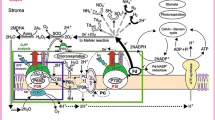Abstract
During sexual differentiation, Chlamydomonas reinhardtii changes its chemotactic behavior in response to ammonium. Just like gamete formation, the change in chemotaxis mode is controlled by the sequential action of two environmental cues, removal of ammonium or nitrate from the medium and light. Thus, vegetative cells and mating incompetent pre-gametes, the latter being generated by nitrogen starvation in the dark, exhibit chemotaxis towards ammonium. Irradiation of pre-gametes results in a loss of chemotaxis and the gaining of mating competence. Incubation of these gametes in the dark resulted in their regaining chemotactic activity; re-illumination again resulted in its loss. Blue light was shown to be most effective in switching-off chemotaxis. RNA-interference strains with reduced levels of the blue-light receptor phototropin showed an attenuated inactivation of chemotaxis that could be partially compensated by the application of higher fluence rates, suggesting that these light responses are mediated by phototropin. The sharing of photoreceptor and signal transduction components as well as similar temporal patterns observed for changes in chemotaxis towards ammonium and gametic differentiation suggest an integration of the signaling pathways that control these two responses.






Similar content being viewed by others
Abbreviations
- mt :
-
Mating type
- Phot :
-
Phototropin
- RNAi :
-
RNA interference
- TAP :
-
Tris–acetate–phosphate (medium)
- TAP−N:
-
Nitrogen-free TAP (medium)
References
Beck CF, Acker A (1992) Gametic differentiation of Chlamydomonas reinhardtii. Plant Physiol 98:822–826
Beck CF, Haring M (1996) Gametic differentiation of Chlamydomonas. Int Rev Cytol 168:259–302
Bonenberger J, Salomon M, Formanek H, Busl T, Ruediger W (1994) A monoclonal anti-phytochrome antibody detects a completely unrelated protein in Chlamydomonas reinhardtii. J Plant Physiol 144:346–350
Briggs WR, Beck CF, Cashmore AR et al (2001) The phototropin family of photoreceptors. Plant Cell 6:993–997
Byrne TE, Wells MR, Johnson CH (1992) Circadian rhythms of chemotaxis and of methylammonium uptake in by Chlamydomonas reinhardtii. Plant Physiol 98:879–886
Christie JM, Briggs WR (2001) Blue light sensing in higher plants. J Biol Chem 276:11457–11460
Ermilova EV, Zalutskaya ZM, Gromov BV (1993) Chemotaxis towards sugars in Chlamydomonas reinhardti. Curr Microbiol 27:47–50
Ermilova EV, Zalutskaya ZM, Munnik T, van den Ende H, Gromov BV (1998) Calcium in the control of chemotaxis in Chlamydomonas. Biologia Bratislava 53:577–581
Ermilova EV, Zalutskaya ZM, Gromov BV, Häder D-P, Purton S (2000) Isolation and characterisation of chemotactic mutants of Chlamydomonas reinhardtii obtained by insertional mutagenesis. Protist 151:127–137
Ermilova EV, Zalutskaya ZM, Lapina T, Nikitin MM (2003a) Chemotactic behavior of Chlamydomonas reinhardtii is altered during gametogenesis. Curr Microbiol 46:261–264
Ermilova EV, Zalutskaya ZM, Lapina T, Nikitin MM (2003b) Effects of nitrogen-containing compounds on change in chemotaxis mode during gametogenesis of Chlamydomonas reinhardtii. Protistology 3:9–14
Furukawa T, Watanabe M, Shihira-Ishikawa I (1998) Blue and green light chloroplast migration in the centric diatom Pleurosira laevis. Protoplasma 203:214–220
Gloeckner C, Beck CF (1995) Genes involved in light control of sexual differentiation in Chlamydomonas reinhardtii. Genetics 141:937–943
Gorman DS, Levin RP (1965) Cytochrome and plastocyanin: their sequences in the photosynthetic electron transport chain of Chlamydomonas reinhardtii. Proc Natl Acad Sci USA 54:1665–1669
Harris EH (1989) The Chlamydomonas sourcebook. Academic Press, San Diego
Herman CA, Im C-S (1999) Light-regulated expression of the gsa gene encoding the chlorophyll biosynthetic enzyme glutamate 1-semialdehyde aminotransferase in carotenoid-deficient Chlamydomonas reinhardtii cells. Plant Mol Biol 39:289–297
Huang K, Beck CF (2003) Phototropin is the blue-light receptor that controls multiple steps in the sexual life cycle of the green alga Chlamydomonas reinhardtii. Proc Natl Acad Sci USA 100:6269–6274
Huang K, Merkle T, Beck CF (2002) Isolation and characterization of a Chlamydomonas gene that encodes a putative blue-light photoreceptor of the phototropin family. Physiol Plant 115:613–622
Johnson CH, Suzuki L (2001) Algae know the time of day: circadian and photoperiodic programs. J Phycol 37:933–942
Kindle KL (1990) High-frequency nuclear transformation of Chlamydomonas reinhardtii. Proc Natl Acad Sci USA 87:1228–1232
Laemmli UK (1970) Cleavage of structural proteins during the assembly of the head of bacteriophage T4. Nature 227:680–685
Nagel G, Ollig D, Fuhrmann M, Kateriya S, Musti AM, Bamberg E, Hegemann P (2002) Channelrhodopsin-1: a light-gated proton channel in green algae. Science 296:2395–2398
Pan J, Haring MA, Beck CF (1997) Characterization of blue light signal transduction chains that control development and maintenance of sexual competence in Chlamydomonas reinhardtii. Plant Physiol 115:1241–1249
Popov N, Schmitt S, Matthies H (1975) Eine störungsfreie Mikromethode zur Bestimmung des Proteingehalts in Gewebshomogenaten. Acta Biol Ger 34:1441–1446
Schroda M, Blöcker D, Beck CF (2000) The HSP70A promoter as a tool for the improved expression of transgenes in Chlamydomonas. Plant J 21:121–131
Schroda M, Vallon O, Whitelegge J, Beck CF, Wollman F-A (2001) Identification and characterization of a chloroplast GrpE homolog. Plant Cell 13:2823–2839
Sineshchekov OA, Jung K-H, Spudich JL (2002) Two rhodopsins mediate phototaxis to low- and high-intensity light in Chlamydomonas reinhardtii. Proc Natl Acad Sci USA 99:8689–8694
Sizova I, Fuhrmann M, Hegemann P (2001) A Streptomyces rimosus aphVIII gene coding for a new type phosphotransferase provides stable antibiotic resistance to Chlamydomonas reinhardtii. Gene 277:221–229
Sjoblad RP, Frederikse PH (1981) Chemotactic responses of Chlamydomonas reinhardtii. Mol Cell Biol 1:1057–1060
Small GD, Min B, Lefebvre PA (1995) Characterization of a Chlamydomonas reinhardtii gene encoding a protein of the DNA photolyase/blue light photoreceptor family. Plant Mol Biol 28:443–454
Treier U, Beck CF (1991) Changes in gene expression patterns during the sexual life cycle of Chlamydomonas reinhardtii. Physiol Plant 83:633–639
Von Gromoff ED, Beck CF (1993) Genes expressed during sexual differentiation of Chlamydomonas reinhardtii. Mol Gen Genet 241:415–421
Acknowledgements
This work was supported by grants from the Russian Foundation for Basic Research to E.V.E. and from the Deutsche Forschungsgemeinschaft to C.F.B.
Author information
Authors and Affiliations
Corresponding author
Rights and permissions
About this article
Cite this article
Ermilova, E.V., Zalutskaya, Z.M., Huang, K. et al. Phototropin plays a crucial role in controlling changes in chemotaxis during the initial phase of the sexual life cycle in Chlamydomonas . Planta 219, 420–427 (2004). https://doi.org/10.1007/s00425-004-1241-6
Received:
Accepted:
Published:
Issue Date:
DOI: https://doi.org/10.1007/s00425-004-1241-6




